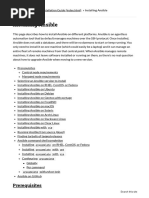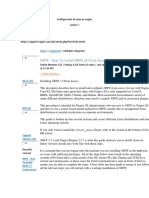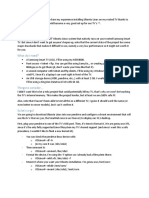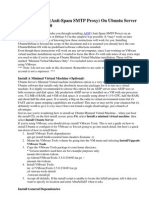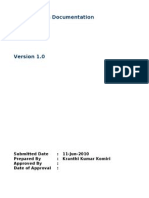What Will Be Installed I. Latest Release Via Yum Ii. Latest Releases Via Apt (Ubuntu)
What Will Be Installed I. Latest Release Via Yum Ii. Latest Releases Via Apt (Ubuntu)
Uploaded by
Amir AzizCopyright:
Available Formats
What Will Be Installed I. Latest Release Via Yum Ii. Latest Releases Via Apt (Ubuntu)
What Will Be Installed I. Latest Release Via Yum Ii. Latest Releases Via Apt (Ubuntu)
Uploaded by
Amir AzizOriginal Description:
Original Title
Copyright
Available Formats
Share this document
Did you find this document useful?
Is this content inappropriate?
Copyright:
Available Formats
What Will Be Installed I. Latest Release Via Yum Ii. Latest Releases Via Apt (Ubuntu)
What Will Be Installed I. Latest Release Via Yum Ii. Latest Releases Via Apt (Ubuntu)
Uploaded by
Amir AzizCopyright:
Available Formats
Installation
What Will Be Installed
Installing the Control Machine
i. Latest Release Via Yum
ii. Latest Releases Via Apt (Ubuntu)
Basics / What Will Be Installed
Latest Release Via Yum
Latest Releases Via Apt (Ubuntu)
asics / What Will Be Installed
Ansible by default manages machines over the SSH protocol. Once Ansible is installed, it will not add a
will be no daemons to start or keep running. You only need to install it on one machine (which could e
can manage an entire fleet of remote machines from that central point. When Ansible manages remot
leave software installed or running on them, so theres no real question about how to upgrade Ansible
version.
atest Release Via Yum
RPMs are available from yum for EPEL 6, 7, and currently supported Fedora distributions. Ansible itself
operating systems that contain Python 2.4 or higher (so also EL5). Fedora users can install Ansible dire
using RHEL or CentOS and have not already done so, configure EPEL
# install the epel-release RPM if needed on CentOS, RHEL, or Scientific Linux
$ sudo yum install ansible
atest Releases Via Apt (Ubuntu)
To configure the PPA on your machine and install ansible run these commands:
$
$
$
$
sudo
sudo
sudo
sudo
apt-get install software-properties-common
apt-add-repository ppa:ansible/ansible
apt-get update
apt-get install ansible
You might also like
- Ansible Docs 1.7Document572 pagesAnsible Docs 1.7hussainshahnawaj7No ratings yet
- Installing Ansible - Ansible DocumentationDocument14 pagesInstalling Ansible - Ansible Documentationjlieghton7157No ratings yet
- Ansible AdsfgfgngnDocument388 pagesAnsible Adsfgfgngnsunil kumarNo ratings yet
- Installing WINE On CentOSDocument2 pagesInstalling WINE On CentOSGitesh MoreNo ratings yet
- Ubuntu InstallDocument7 pagesUbuntu InstallWhisky MiloNo ratings yet
- Ansible Setup BookDocument24 pagesAnsible Setup BookAung Aung100% (1)
- AnsibleDocument392 pagesAnsibleRamy GeorgeNo ratings yet
- Devops Project 1 Install Puppet Server On Master NodeDocument37 pagesDevops Project 1 Install Puppet Server On Master NodeNagaraju RjNo ratings yet
- Prerequisites: Installing Ansible-CoreDocument3 pagesPrerequisites: Installing Ansible-Coremarius aurelNo ratings yet
- Ansile Office DocumentDocument8 pagesAnsile Office Documentshrinath bhatNo ratings yet
- AnsibleDocument4 pagesAnsiblemohitNo ratings yet
- How Do I Update Ubuntu Linux Software Using Command LineDocument15 pagesHow Do I Update Ubuntu Linux Software Using Command LinegaschonewegNo ratings yet
- Installation Softwares in UbuntuDocument32 pagesInstallation Softwares in UbuntuZahidHameedNo ratings yet
- Orange Pi Zero - Ubuntu Core User ManualDocument19 pagesOrange Pi Zero - Ubuntu Core User ManualMarlon ChalloutsNo ratings yet
- VU Find UBUNTU Legacy - Installation - Ubuntu (VuFind Documentation)Document3 pagesVU Find UBUNTU Legacy - Installation - Ubuntu (VuFind Documentation)Farhan AliNo ratings yet
- Virtual Domain ConfigurationDocument36 pagesVirtual Domain ConfigurationsatishnuniNo ratings yet
- Network Automation Cookbook Pdf00007Document5 pagesNetwork Automation Cookbook Pdf00007Dang KhueNo ratings yet
- Unit Iv Configuration Management Using Ansible NotesDocument49 pagesUnit Iv Configuration Management Using Ansible Notesnagalakshmi30599No ratings yet
- Unicenta Opos: Installation GuideDocument11 pagesUnicenta Opos: Installation GuideDaniel PedrazaNo ratings yet
- Install GCC 4.7 On RHEL 6Document3 pagesInstall GCC 4.7 On RHEL 6Zhou Yupeng PaulNo ratings yet
- Install Scip yDocument6 pagesInstall Scip yharshasbhatNo ratings yet
- ANSIBLE IntroductionDocument18 pagesANSIBLE IntroductionMaxwell de AlmeidaNo ratings yet
- Tiny OS and Installing Tiny OS On Ubuntu - CentOS - Fedora - Red HatDocument2 pagesTiny OS and Installing Tiny OS On Ubuntu - CentOS - Fedora - Red HatlovelyeceNo ratings yet
- Aerospike Installation in UbuntuDocument2 pagesAerospike Installation in UbuntuRakesh BhardwajNo ratings yet
- How To Install Ubuntu Netbook Remix On The Asus Eee PCDocument6 pagesHow To Install Ubuntu Netbook Remix On The Asus Eee PCIdi JakSel RsfNo ratings yet
- Guac Page 1Document1 pageGuac Page 1naparanphilipvNo ratings yet
- Install Apache and Allow It To Get Documents From NFS Mounted FolderDocument3 pagesInstall Apache and Allow It To Get Documents From NFS Mounted FolderMaher MechiNo ratings yet
- How To Install Ajenti Control Panel On CentOSDocument2 pagesHow To Install Ajenti Control Panel On CentOSLevinoNo ratings yet
- Load Balanced High-Availability Apache ClusterDocument12 pagesLoad Balanced High-Availability Apache ClusterSyahroni AbenNo ratings yet
- Quartus On UbuntuDocument14 pagesQuartus On UbuntuTien_Do_6932No ratings yet
- Install Asterisk 11 On CentOS 6.4.odtDocument4 pagesInstall Asterisk 11 On CentOS 6.4.odtMaicon Glauco AleixoNo ratings yet
- Vmware Workstation Installation Guide For UbuntuDocument1 pageVmware Workstation Installation Guide For UbuntuGowtham Saran DuraiswamyNo ratings yet
- InstallingasterisknowDocument12 pagesInstallingasterisknowJhonAlexanderNo ratings yet
- Configuration:: Sudo Apt-Get Install Apache2 Php5-Mysql Libapache2-Mod-Php5 Mysql-ServerDocument2 pagesConfiguration:: Sudo Apt-Get Install Apache2 Php5-Mysql Libapache2-Mod-Php5 Mysql-ServerSiva RamakrishnanNo ratings yet
- Installing VMware PlayerDocument6 pagesInstalling VMware PlayerRakesh BhardwajNo ratings yet
- Nstructions For Setting Up A New Raspberry Pi OS and OpenCVDocument6 pagesNstructions For Setting Up A New Raspberry Pi OS and OpenCVChrista SutharsanNo ratings yet
- Firewall UfwDocument10 pagesFirewall UfwAna Lilia Rodriguez MartinezNo ratings yet
- How To Upgrade From CentOS 6 To 7 - Nam Huy LinuxDocument16 pagesHow To Upgrade From CentOS 6 To 7 - Nam Huy LinuxnamhuylinuxNo ratings yet
- AsteriskNow Manual InstallationDocument14 pagesAsteriskNow Manual InstallationRufino Victor SaballaNo ratings yet
- What Is FreenxDocument13 pagesWhat Is FreenxBenor OrNo ratings yet
- Configuración de Nrpe en NagiosDocument14 pagesConfiguración de Nrpe en NagiosCarlos SuárezNo ratings yet
- PHPCZ 3 o QNDocument3 pagesPHPCZ 3 o QNapi-99991675No ratings yet
- Create Windows - Linux Bootable USB Using Etcher - ComputingForGeeksDocument5 pagesCreate Windows - Linux Bootable USB Using Etcher - ComputingForGeekstech.quegiangNo ratings yet
- Reinstall Xfce DesktopDocument4 pagesReinstall Xfce Desktopnic bNo ratings yet
- Readme EngDocument7 pagesReadme EngAndres AvelinoNo ratings yet
- How to Successfully Install Huawei ENSP in 3 StepsDocument43 pagesHow to Successfully Install Huawei ENSP in 3 StepsDouglas KamgaNo ratings yet
- Ubuntu On Samsung Smart TVDocument13 pagesUbuntu On Samsung Smart TVDilip ThummarNo ratings yet
- Linux ComputerDocument15 pagesLinux ComputerMervidelleNo ratings yet
- Package Management: Sudo Service SSH StartDocument7 pagesPackage Management: Sudo Service SSH Starttmukesh62No ratings yet
- OSCAR Install Guide - Indivica - 2Document27 pagesOSCAR Install Guide - Indivica - 2Radovan KordaNo ratings yet
- AIX Manual InstallDocument38 pagesAIX Manual InstallkurtisaliveNo ratings yet
- 13 Software ManagementDocument12 pages13 Software ManagementadeelpfizerNo ratings yet
- Installing ASSPDocument6 pagesInstalling ASSPswami_rjtNo ratings yet
- How To Use UFW Firewall On Debian, Ubuntu, Linux MintDocument18 pagesHow To Use UFW Firewall On Debian, Ubuntu, Linux MintTwom AliNo ratings yet
- Ansible TutorialDocument33 pagesAnsible Tutorialenter51No ratings yet
- UNIX Process Documentation TL UpgradeDocument4 pagesUNIX Process Documentation TL UpgradeRakesh Yadav MNo ratings yet
- Flash Your Lenovo Ideapad Laptop BIOS From Linux Using UEFI Capsule UpdatesDocument11 pagesFlash Your Lenovo Ideapad Laptop BIOS From Linux Using UEFI Capsule UpdatesPuican IulianNo ratings yet
- DEVOPS_NOTESDocument24 pagesDEVOPS_NOTESbikotreslo.99No ratings yet
- Ansible Configuration Management - Second EditionDocument19 pagesAnsible Configuration Management - Second EditionPackt PublishingNo ratings yet
- A Beginner's Guide To LVMDocument6 pagesA Beginner's Guide To LVMAmir AzizNo ratings yet
- Dell Bckup and Recvry Mangr v1.3 User's Guide en UsDocument44 pagesDell Bckup and Recvry Mangr v1.3 User's Guide en UsAmir AzizNo ratings yet
- Fstab DemystifiedDocument2 pagesFstab DemystifiedAmir AzizNo ratings yet
- NIM Install MethodsDocument17 pagesNIM Install MethodsAmir AzizNo ratings yet
- AIX Mirror and Disk Replace StepsDocument1 pageAIX Mirror and Disk Replace StepsAmir AzizNo ratings yet
- How To Create and Delete VLAN On Cisco Catalyst SwitchDocument3 pagesHow To Create and Delete VLAN On Cisco Catalyst SwitchAmir AzizNo ratings yet

